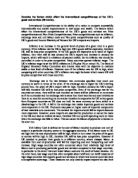Structured Response a) + b) on Absolute Advantage, Comparative Advantage and Trade ( [8] + [12] marks, 45 minutes)
1. In a two country world, one country is more efficient at producing one product and the other country is more efficient at producing another product, explain why specialisation and trade usually benefit both countries. [8]
In the case where a country can produce a given product more efficiently than another, it means that the country happens to have an absolute advantage in the production of said good, hence, if both countries allocate equal amounts of resources to the production of said good, the country with the absolute advantage will be able to produce more of it. This absolute advantage can be due to a number of reasons ranging from factor endowment, making it easier for a country to harvest the raw materials required for the production of a good, pre-existing infrastructure providing the framework for more efficient production or higher levels of education leading to greater worker productivity. In turn, given that one country has an absolute advantage in the production of one good while the other has an absolute advantage in the production of the other, a comparative advantage for both countries arises in the production of the good that they are more efficient at producing, meaning that they can produce the good at a lower opportunity cost than the other country, thus creating a basis for trade.
Take the example given in the table where the output of the countries is predicted based on the assumption that they both have the same resources and they are divided evenly between the production of chairs and tables. As can be seen, with the same resources, Country A can produce 40 more tables than country B, while country B can produce 60 more chairs with the same resources. Beyond this, Country A can produce Tables at an opportunity cost to chairs of 5:3 while Country B can only produce them at an opportunity cost of 1:2. As such if both countries specialise in the product that they are more efficient at, as illustrated in Table 2, they can increase the total quantity produced of both goods, and, as such, if they trade between each other at a ratio somewhere between their opportunity costs, both countries will be able to consume more than if they would not have been able to trade. This is then beneficial by allowing for a more efficient use of the scare resources available, helping ease the basic economic problem, which, in turn, allows for a higher level of consumption of the goods concerned in both countries, thus leading to an increase in welfare. Moreover, given that such a trade analysis model cannot account for increasing returns to scale associated with economies of scale, the potential benefits are likely under-evaluated, and, when practically implemented are likely to be substantially greater, thus being even more beneficial than predicted.



![Structured Response a) + b) on Absolute Advantage, Comparative Advantage and Trade ( [8] + [12] marks, 45 minutes)](https://mbt-essays-prod-public.s3.eu-west-1.amazonaws.com/1216959/listing/1216959_1.jpg)

![Discuss whether inflation is necessarily harmful [12 marks] (27 minutes)](https://mbt-essays-prod-public.s3.eu-west-1.amazonaws.com/1216945/listing/1216945_1.jpg)
![Explain the difficulties in measuring inflation accurately [8 marks] (18 minutes)](https://mbt-essays-prod-public.s3.eu-west-1.amazonaws.com/1216943/listing/1216943_1.jpg)


![Discuss whether national defence or a public park is the better example of a public good. [12]](https://mbt-essays-prod-public.s3.eu-west-1.amazonaws.com/1216969/listing/1216969_1.jpg)